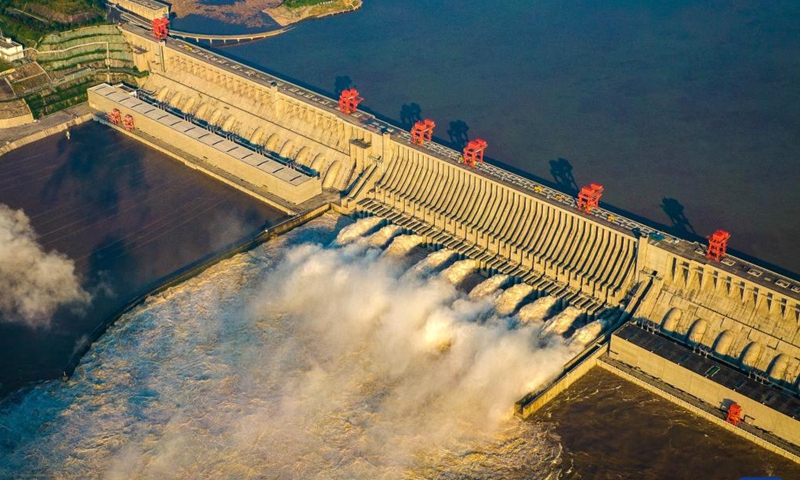
An aerial drone photo taken on Aug. 19, 2020 shows water gushing out from the Three Gorges Dam in central China's Hubei Province. The Three Gorges project, the world's largest hydropower project, has generated over 1.7 trillion kWh of electricity. It marked the 30th anniversary of its construction on Saturday.
The Three Gorges project - the world's largest hydropower project - celebrated the 30th anniversary of its construction on Saturday, gaining widespread attention from Chinese media on Sunday for its various contributions to the country's high-quality economic and social development.
The project has generated over 1.7 trillion kWh, equivalent to saving 550 million tons of standard coal and reducing carbon dioxide emissions by 1.49 billion tons, the Xinhua News Agency reported on Sunday.
Industrial development in the Three Gorges Reservoir area has also been greatly bolstered, supporting 468,000 mu (31,200 hectares) of ecological agricultural parks, cultivating multiple distinctive agricultural brands such as Zigui navel oranges from Central China's Hubei Province and Fuling zhacai (pickled mustard tubers) from Southwest China's Chongqing, as well as constructing 21 ecological industrial parks, Guangming Ribao reported on Sunday.
As of the end of 2023, Zigui's output value of navel oranges reached 120 million yuan ($16.49 million), with per capita sales income of the fruit exceeding 40,000 yuan, the Global Times previously learned from the Zigui county government.
The formation and development of competitive specialty industries has not only raised the incomes of residents but also provided strong support for the transformation and upgrading of the regional economy, Wang Peng, an associate research fellow at the Beijing Academy of Social Sciences, told the Global Times on Sunday.
The economic development of the Three Gorges Reservoir area has also been progressing steadily, with the GDP achieving an average annual growth rate of 15.9 percent and 941,000 new jobs being created, per the report from Guangming Ribao.
In addition, it has intercepted floods nearly 70 times, and regulated and supplemented water for the middle and lower reaches of the Yangtze River for 2,732 days, with a total water supplement of over 360 billion cubic meters, according to Xinhua.
As for improving the ecological environment in the Three Gorges Reservoir area, the daily sewage treatment capacity has increased by 1.58 million tons. The forest and grass coverage in key areas has increased by 4.47 million mu, with a forest coverage rate exceeding 50 percent, thus enhancing soil and water conservation capabilities, per Guangming Ribao.
Wang said that the achievements made through the operation of the Three Gorges project in regional industrial and economic development have positively fueled the country's overall economic development.
For instance, Wang noted that improving shipping conditions of the Yangtze River and promoting regional economic connectivity is conducive to promoting the coordinated development of the domestic economy.
The project has improved navigation on the Yangtze River, with a cumulative cargo throughput of over 2.1 billion tons and an annual average economic benefit of 34.4 billion yuan, per the Xinhua report.
Wang said that the development experience of the Three Gorges project, such as developing economies with ecological protection, utilizing local advantages, enhancing construction of infrastructure and industrial upgrading, can serve as examples for other regions in China to use as a reference.
Global Times




